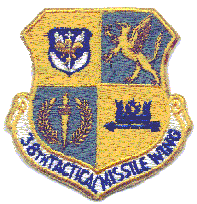|
Sembach Air Base
Hahn AB
Bitburg AB
Kadena AB
Osan AB
Tainan AB
Lowry AFB
Wheelus AB
Orlando AFB
Camp Happiness
Missile History I
Missile History II
Missile History III
The MM-1
Collectibles
Home Page
|
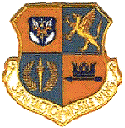 | Sembach Air Base
GermanyHeadquarters - 38th Tactical Missile Wing18 June 1958 - 25 September 1966 |  |

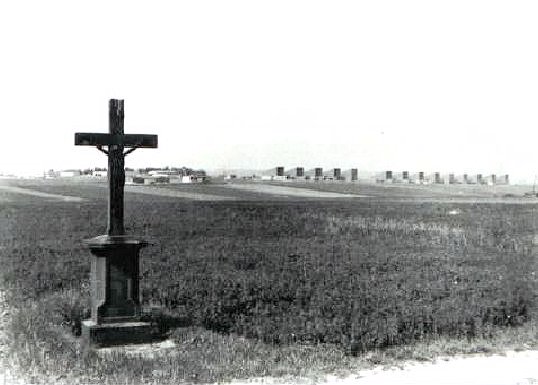 | Grünstadt
Photograph by Phillip Thomas, (pthomas214@cfl.rr.com) courtesy of Phillip and Bob Bolton (olliesnapper@gmail.com) |

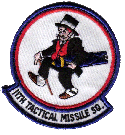 | The 11th Tactical Missile Squadron, the first Matador missile squadron at Sembach, was attached to 7382nd Tactical Missile Group on 1 July 1956. The 11th TMS was originally activated 17 June 1954 at Orlando AFB, Florida, as the 11th Pilotless Bomber Squadron, 9th Air Force (TAC). The unit was redesignated the 11th Tactical Missile Squadron on 08 June 1955 prior to its deployment to Germany when it was relieved 9th AF, TAC, and was reassigned to United States Air Forces Europe. On 15 September 1956, the 7382nd Tactical Missile Group was inactivated and replaced by the newly activated 587th Tactical Missile Group, part of the newly activated 701st Tactical Missile Wing, headquartered at Hahn Air Base. On 18 June 1958, the 11th TMS was inactivated and replaced with the 822d Tactical Missile Squadron, 587th Tactical Missile Group, no change of station, with the activation of the 38th Tactical Missile Wing at Hahn AB and the deactivation of the 701st TMW.
On 1 September 1959, Sembach became USAFE's primary missile base when the 38th Tactical Missile Wing headquarters moved from Hahn Air Base to Sembach Air Base. The three Tactical Missile Groups assigned as part of the 38th TMW in 1958 continued with their assignments: the 587th TMG at Sembach, the 586th TMG at Hahn AB, and the 585th TMG at Bitburg AB. The 38th TMW underwent a fundamental reorganization on 25 September 1962 when it took command of the 822d TMS from the 587th Tactical Missile Group, when the three Tactical Missile Groups were inactivated, concurrent with the retirement of the TM-61C Matador. Inactivated the same day along with the 587th TMG were the 586th Tactical Missile Group at Hahn Air Base and the 585th Tactical Missile Group at Bitburg Air Base. Concurrently, two additional squadrons, the 823d and 887th TMSs were activated at Sembach. The 823d Bombardment Squadron had been inactivated 12 April 1946, but was reactivated and renamed the 823d Tactical Missile Squadron, 10 September 1962, assigned to the 38th TMW at Sembach AB on 18 September 1962. The TM-61 Matador missile had been replaced with the TM-76A Mace at Hahn and Sembach, while the TM-76B was being brought operational at Bitburg AB with the 71st TMS. The 38th TMW and its subordinate units were inactivated, except for the 71st TMS which was transferred to the 36th Tactical Fighter Wing, on 25 September 1966 and the 603d Air Base Wing took over host duties for Sembach Air Base. All TM-76A, then renumbered to MGM-13A, Mace tactical missile operations at Sembach AB and Hahn AB were inactivated and the remaining 71st Tactical Missile Squadron at Bitburg Air Base, transferred to Bitburg's host 36th Tactical Fighter Wing, remained on active duty with the CGM-13B (TM-76B) Mace until April 30th, 1969. |

U.S. Air Force Tactical Missiles
By the Editors of this Website!Beyond the Web Page... The only book devoted exclusively to the Matador and Mace Tactical Missiles. The book reveals the story from the initial idea that became the first U.S. pilotless bomber, through the politically troubled development of the ever evolving deployment methods of the Matador and Mace Tactical Missiles. It covers the Units, Groups, Squadrons and Wing that fielded the missiles. From the United States test sites, Europe, Asia and North Africa nothing is omitted. All phases of the application of these two missiles by the U.S. Air Force (and West German Luftwaffe) are included, from the first tentative launches of the XSSM-A-1 Matador in January 1949, to the tense alert duty of the Cuban Missile Crisis, and the final launch of a MQM13A in May of 1977. The maintenance, logistics and launch, the men, equipment and tactics are all there. |
"Bob, George, I finished your book 2 days after I received it. Couldn't put it down. It was incredible reading and incredibly detailed information." Kent Washburn (KWASH55@aol.com) Mace B, Kadena, Okinawa
"George and Bob. I want you both to know how much I enjoyed reading and how much I admire and appreciate what you have accomplished in developing and publishing "The Pioneers". It is truly an outstanding piece of work, reflecting the time and effort required to produce it, but is also a formidable contribution to our military history. I mentioned in some earlier correspondence that I was a little disappointed in the relatively small amount of information regarding the Operating Location/Guidance Sites but you largely made up for it with this magnificent book." Dale Lake (daleflake@yahoo.com) 601st Tactical Control Squadron, 38th TMW, Hamm, Germany
"I just finished your book, The Pioneers, et al. Please accept my "job well done!" Not only is it informative, but it's very readable. I'd also like to complement you on how well you footnoted it. You have shown that a scholarly work can be both instructive and enjoyable." Michael Roof (lavinaschnur@hotmail.com) SGM USA (Ret.)
| 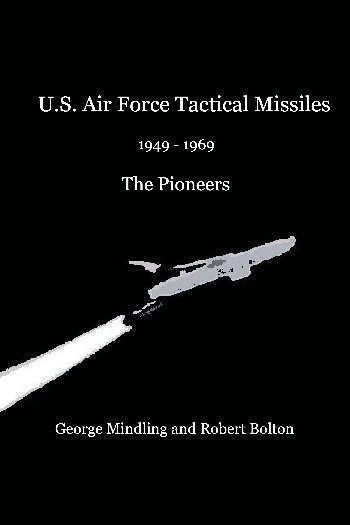 ISBN 978-0-557-00029-6
"Very good work with great detail." Col. Charlie Simpson, USAF, Retired
Executive Director
Association of Air Force Missileers
"George, the book arrived on Tuesday while I was off to France. Of course, I quickly read the chapter about Germany's quiet step into the realm of nuclear armament. You know, this is still a widely ignored fact over here...
...For me it is fascinating to see what the picture really was in the 1950s and 1960s as opposed to what the official communication of the time wanted people to believe. A fascinating book shedding some light on the early days of tactical nuclear missiles as well as the political background that even today is still largely hidden behind the propaganda of the time. Can't wait to read the rest of it." Burkhard Domke
Harsefeld, Germany
"U.S. Tactical Missiles 1949-1969 The Pioneers" | "I have your excellent book on USAF tactical missiles. I actually witnessed the decommissioning of the Maces at Wüscheim back in 1966." Paul Offen
Talitha, Tye Common Road
Billericay
Essex CM12 9PX
UK
"I just wanted to drop you a line and tell you how much I enjoyed the book that you and Bob wrote. The history was of particluar interest to me and my brother who was a history Professor at the University of Wisconsin. He also thought the book was well written, and he now knows what his little brother, (me), did while in Germany for three years." George Joseph Snyder (gjsnyder@lanset.com)
71st TMS, Steinborn, Germany
"...by the way, I read your book, it was great, thanks for writing it." Hack Hunton (hack@sstelco.com) Mace B, Kadena, Okinawa |
US Air Force Tactical Missiles ©2008 - George Mindling and Robert Bolton | Inspired by the 38th TMW Website, George Mindling and Robert Bolton co-authored US Air Force Tactical Missiles 1949 - 1969: The Pioneers ©2008, the story of America's first operational missiles, from the Matador to the Mace, from Taiwan, Korea, and Okinawa to Germany, including Lowry, Orlando, Holloman, Santa Rosa Island at Eglin, and even Camp Happiness! |
|
Dieses Buch ist ein Muss für alle, die im Rahmen ihres Dienstes bei der U.S. Air Force mit den frühen Marschflugkörpern zu tun hatten, aber auch für deutsche Militärarchäologen, die in der Eifel, im Hunsrück oder im Pfälzer Wald schon über rätselhafte Hinterlassenschaften gestolpert sind. Nach mehr als 40 Jahren wird endlich eine Fälle von Fakten, Informationen und Geschichten zu den zwischen 1954 und 1969 in Deutschland stationierten, mit Automwaffen ausgerüsteten amerikanischen Matador und Mace auf den Tisch gelegt. Ausführlich und lebendig erzählen George Mindling und Bob Bolton von den jungen Missilemen, die im März 1954 erstmals in Bitburg ankamen - noch ganz grün im Gesicht, weil auf dem Atlantik schwerer Sturm geherrscht hatte. Von den T-33-Flugzeugen, die aus übungsgründen so taten, als wären sie Matador-Flugkörper, über die Startstellungen hinweg in Richtung deutsch-deutsche Grenze donnerten und sich von der Gegenseite nur nicht erwischen lassen durften. Oder von der Kuba-Krise, als die US Air Force Europe auf DEFCON 3 ging und an die Mechaniker in Bitburg Munition für ihre Karabiner ausgegeben wurde.
Augenzeugen sagen dazu: "Wir hätten die Vögel auf jeden Fall innerhalb von 15 Minuten in der Luft haben müssen!" Es ist lebendige Militärgeschichte, die nun nicht der Vergessenheit anheimfällt, sondern jedermann zugänglich wird - auch für die ortsansässige Bevölkerung, die heute endlich erfährt, was sich damals in ihrer Nachbarschaft zugetragen hat. Den beiden Autoren gebührt der Dank.
Klaus Stark (klaus_stark@t-online.de)
Berlin, Germany
This book is not only a must for all those who served in the U.S. Air Force with the early cruise missiles, but also for German military archeologists who have been puzzling over relics stumbled across in the Eifel, the Hunsrück and the Palatinate Forests. After more than 40 years, we finally have a wealth of facts, information and stories, from 1954 to 1969, of the nuclear equipped American Matador and Mace missiles stationed in Germany placed on the table.
With detailed and vivid descriptions, George Mindling and Bob Bolton talk about the young Missilemen who arrived for the first time in March, 1954, in Bitburg - still green in the face, having prevailed the Atlantic crossing in major storm. Of the T-33 aircraft which practiced as if they Matador missiles launched in the direction of German-German border, or from the Cuban missile crisis, when the U.S. Air Force Europe went on DEFCON 3 and was issued ammunition to the mechanics in Bitburg for their rifles. Eyewitnesses say: "We would have to have the birds in the air in any event within 15 minutes!"
It is vital military history that is prey to oblivion, but is now accessible to everyone - even for the local population, which today finally learns what happened at that time in their neighborhood.
The two authors deserve thanks for saving the history.
Klaus Stark,
klaus_stark@t-online.de
Berlin, Germany
|
 |
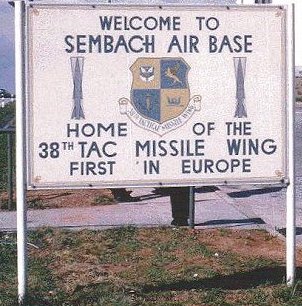
Photograph courtesy of Paul Holmberg
Mace & Matador TAC Missile Association |
"It's was a long time ago, but when you enjoyed what you did back then, some things stick out. It's been a long time since I was at Sembach, but I'll never forget the place or the people, both American and German, they were all good to me.
The 587th Command & Guidance Squadron began as the 11th Tactical Missile Squadron at Orlando Air Force Base at Orlando, Florida, in 1955. The unit was formed there and trained for about 9 months, then was airlifted, with families, equipment & personnel to Sembach, Germany. Shortly after arriving, we became the 587th Command & Guidance Squadron and the Matador was our missile. We were assigned to different areas to set up the guidance systems for the missiles. We went to Wheelus Air Base, in Tripoli, Libya, twice a year to fire a missile and test the guidance system.
My time at Sembach was very enjoyable, I met a lot of great people, both American and German. Sure wish I could see them all again. I lived in the barracks right behind the service club which was handy to most everything.
Hope this note reaches someone who was there at this time,
June, 1956 - Dec, 1957."
Bill Baney, Decatur, IL. (BANEYWM@msn.com) |

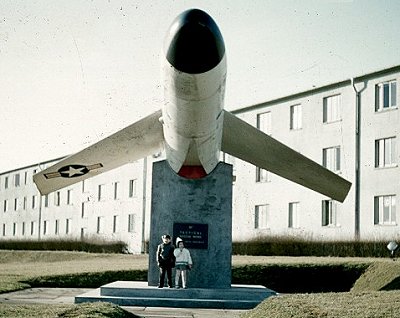
The famous TM-76A (MGM-13A) with the TM-61C Matador Wings
38th Tactical Missile Wing Headquarters
Sembach Air Base, Germany, 1962 Photograph courtesy of Thomas Seelig(tomseelig@embarqmail.com) |
 USAF Art
"Our Mace And Matador Missiles Ready To Guard Freedom In Germany, Europe And The Entire Free World, Are Themselves Guarded Around The Clock. Shown Here, They Are Guarded By Teams Of Men And Police Dogs Patrolling The Area Through The Night.This Was A Phase Of Air Force Operations I Felt Important Enough To Portray As Dramatically As Possible. To This End, I Used Strong Color Contrasts, Powerful Sweeping Brush Strokes And A Dynamic Composition To Create This Scene Of Impending Unleashed Might."
MISSILE GUARDS - SEMBACH, GERMANY
Artist: Donald Moss | 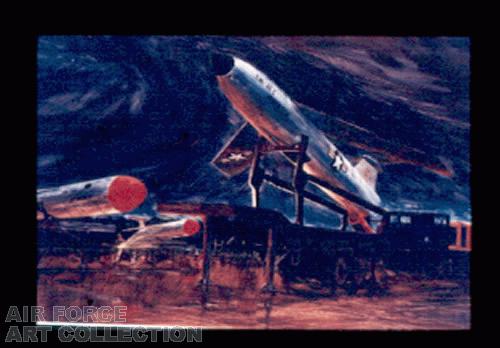 |

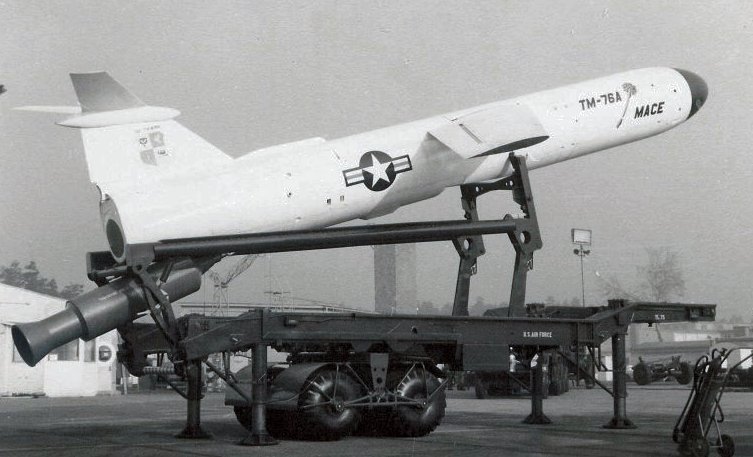
The 38th Tactical Missile Wing TM-76 "A" Show Bird.
Photo by John W. Cook SMSgt, USAF, (Ret) (Cookieman1@cox.net) |
 |
USAF Art
"While Touring Defense Bases In Germany, The Sight Of These Missiles Cradled On The Launching Mechanisms Struck Me As Symbolic Of Our Defense Of Eyrope. The Aircraft Streaking Through An Almost Eternally Clouded Sky And The Old German Village Nestled In The Background Complete The Picture.Paradoxically, While The German Farmers Go About Their Business Of Tending The Fields, USAF Personnel Thousands Of Miles From Their Own Homes Are Engaged In The Grim Business Of Constant Nuclear Vigilance."
MACE MISSILES - SEMBACH, GERMANY
Artist: Donald Moss | 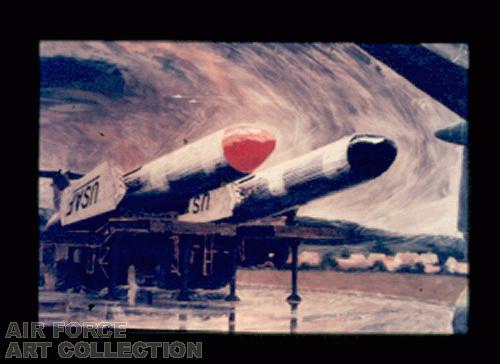 |

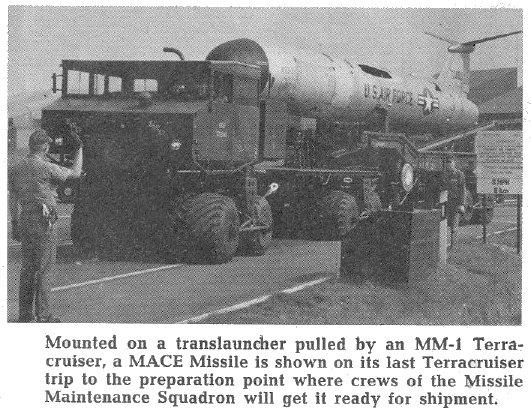 The above Sembach Sentinel photograph courtesy of Bernie Ganshert, Msgt, USAF,(Ret) (ganshertbm@gpcom.net)
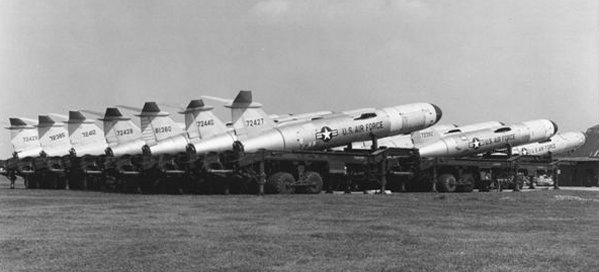 | 25 September 1966 - The "A" Birds come off target, and are temporarily stored, minus wings, before being shipped back to the U.S. and duty as drones at Eglin AFB in Florida. The shut down of the 38th TMW and the MGM-13A did not affect the 71st Tactical Missile Squadron at Bitburg which transferred to the 36th Tactical Fighter Wing and maintained the CGM-13B until 30 April 1969. | Photo courtesy of Ken Lasher (Kenlasher@cox.net)
|

  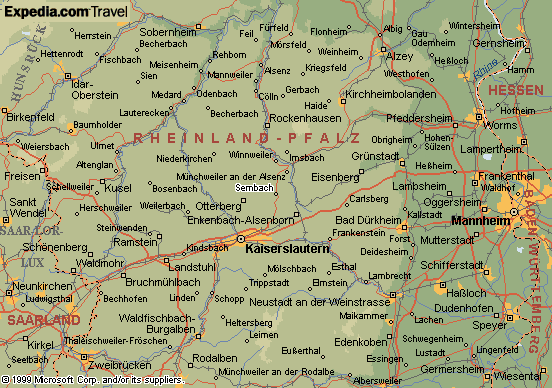

MORE LINKS TO SEMBACH AND THE RHEINLAND!
This page is in no way sponsored or endorsed by the United States Air Force.
Opinions and views expressed are those of the author and not necessarily those of the Department of the Air Force.
|
Web Page Design and Development by
George Mindling - Port Charlotte, Florida
©George Mindling - 2003-2006, 2018 All Rights Reserved
|
|
|
